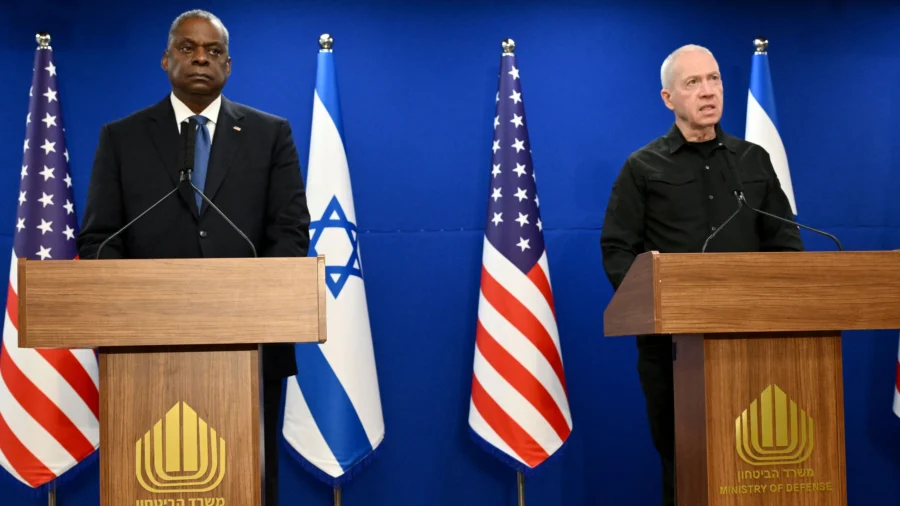Secretary of Defense Lloyd Austin said Monday that he had urged his Israeli counterparts to limit their military operations in the Gaza Strip and start taking a “more surgical” approach when striking the Hamas terrorist group.
The U.S. secretary of defense arrived in Israel on Monday and met with Israeli Prime Minister Benjamin Netanyahu and Israeli Defense Minister Yoav Gallant to discuss the ongoing Israel–Hamas conflict. At a press conference on Monday, Mr. Austin said he shared advice with the Israeli side about preventing the current conflict from expanding beyond the Gaza Strip, and transitioning to a lower intensity of operations within the Gaza Strip.
“We had great discussions about the status of the campaign, about goals and objectives, and about how to reduce harm to civilians in the battlespace and in the need to ensure a sustained flow of humanitarian assistance and capacity,” Mr. Austin said. “We can offer some insight based upon our own experience in fighting terrorist groups and certainly, that enabled us to have great, great discussions. And we also have some great thoughts about how to transition from high-intensity operations to lower intensity and more surgical operations.”
Mr. Austin’s comments about lowering the intensity of combat in the Gaza Strip and being more “surgical” with its military operations come amid growing international calls to wind down the fighting in the Gaza Strip. Earlier this month, nearly the entire United Nations Security Council voted in favor of a ceasefire resolution in the Gaza Strip, before the United States vetoed the measure. Days later, the U.N. General Assembly voted overwhelmingly in favor of a non-binding resolution calling for a ceasefire.
On Friday, Israeli forces admitted to mistakenly killing three hostages who’d been taken captive by Hamas on Oct. 7. That same day, the Qatari state-funded news agency Al Jazeera claimed one of their journalists was killed by an Israeli drone strike as he was reporting at a school in the southern Gaza Strip city of Khan Yunis.
Efforts to reduce civilian casualties may require Israeli forces to limit their use of artillery and aircraft and instead rely on ground troops to attack suspected Hamas targets. This strategy could reduce the risk of civilians being inadvertently killed by airdropped bombs or indirectly fired artillery shells, but would entail exposing Israeli ground troops to a greater degree of risk. Just last week, nine Israeli soldiers were killed in an ambush as they searched through buildings in Gaza’s dense Shijaiyah neighborhood.
On the other hand, if the Israeli side keeps pursuing military operations without further efforts to protect Gaza’s civilian population, they risk inviting international condemnation and radicalizing future generations of Palestinian enemies. According to the Gaza Health Ministry, which operates under the auspices of Hamas’s political control of the Gaza Strip, around 19,000 Gaza residents have been killed in the fighting since Oct. 7. Recent polling has indicated Palestinian support for the terrorist group has risen since Oct. 7.
Mr. Austin said the U.S. and Israeli militaries both value the protection of their troops and acknowledged battling through the Gaza Strip while avoiding civilian casualties poses a challenging task. He said Gaza City already represents a “three-dimensional battlespace” with “very close spaces” and a “dense population of people” and the challenge is compounded by indications Hamas intentionally places its strategic facilities close to sensitive sites like hospitals, mosques, and churches, all of which create “an additional burden for the forces that are kind of prosecuting this fight.”
At the Monday press conference, Mr. Gallant expressed some willingness for the Israeli side to enter a less intense phase of the war in the Gaza Strip.
“The circumstances are changing, you change your efforts and you do something different in a different phase,” Mr. Gallant said.
Mr. Gallant did not specify what benchmarks Israel would set before moving on to the next phase of the fighting, but insisted Israel’s goal continues to be “destroying Hamas’s military capability and its ability to govern in Gaza.” Mr. Gallant said there is no set timeline for Israel to complete its military operations in the Gaza Strip.

